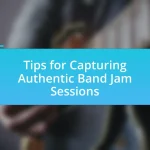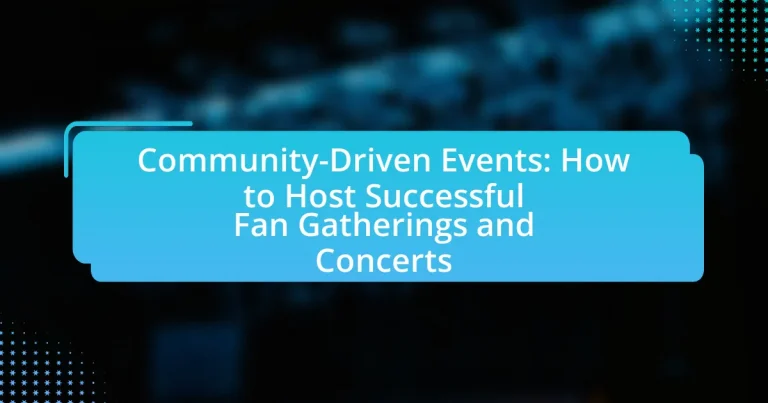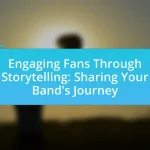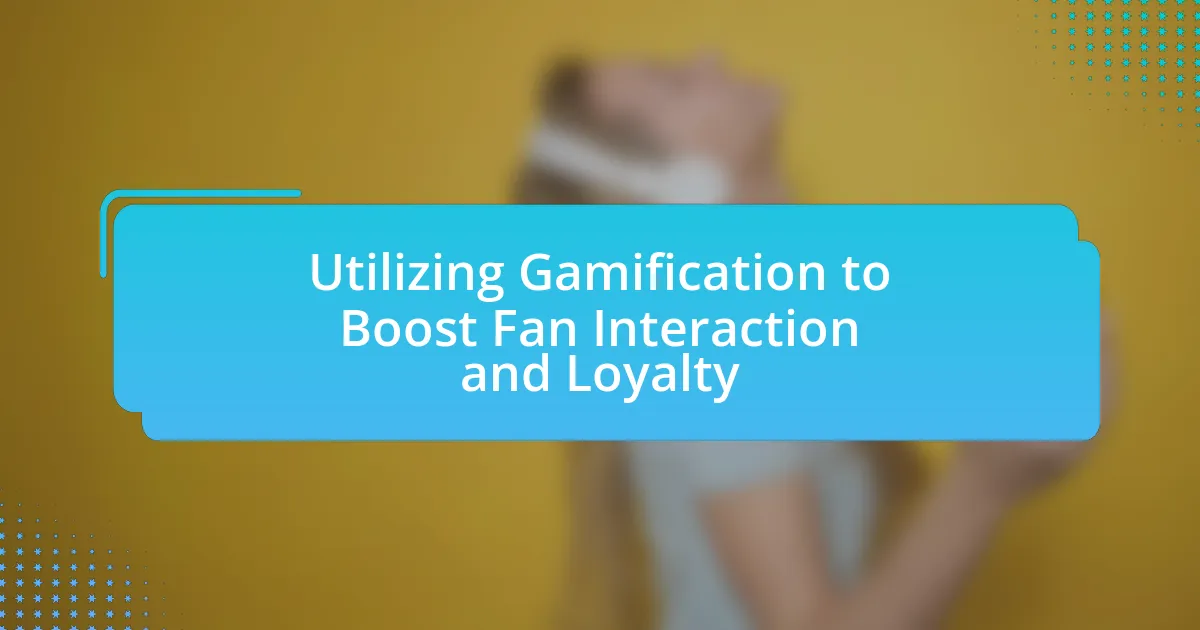Community-driven events are gatherings organized by community members that emphasize shared interests and goals, fostering collaboration and engagement. This article explores the characteristics and importance of these events, particularly in enhancing fan engagement and community ties. It outlines the differences between community-driven and traditional events, highlights various types of gatherings, and provides practical steps for planning successful fan events and concerts. Additionally, it addresses logistical considerations, promotional strategies, and best practices to ensure positive attendee experiences and community involvement.

What are Community-Driven Events?
Community-driven events are gatherings organized and executed by members of a community, focusing on shared interests or goals. These events often foster collaboration, engagement, and a sense of belonging among participants, as they are typically designed to reflect the community’s needs and preferences. For instance, local festivals, workshops, and fan meet-ups exemplify community-driven events, as they encourage active participation and input from community members in the planning process. Research indicates that such events can enhance social cohesion and strengthen community ties, making them vital for community development and engagement.
How do Community-Driven Events differ from traditional events?
Community-Driven Events differ from traditional events primarily in their level of participant engagement and ownership. In community-driven events, the community actively collaborates in the planning, execution, and decision-making processes, fostering a sense of belonging and shared responsibility. This contrasts with traditional events, where organizers typically control all aspects, leading to a more top-down approach. Research indicates that community-driven events often result in higher attendee satisfaction and stronger community bonds, as participants feel their input is valued and impactful. For example, a study by the National Endowment for the Arts found that community involvement in event planning significantly enhances the overall experience and encourages ongoing participation in future events.
What are the key characteristics of Community-Driven Events?
Community-driven events are characterized by active participation, collaboration, and ownership from the community members. These events prioritize the needs and interests of the community, ensuring that the planning and execution reflect their preferences. For instance, community-driven events often involve local input in decision-making processes, fostering a sense of belonging and engagement among participants. Additionally, they typically emphasize inclusivity, allowing diverse voices to contribute, which enhances the overall experience and strengthens community bonds. Research indicates that events with high community involvement lead to increased satisfaction and a stronger sense of community identity.
Why are Community-Driven Events important for fan engagement?
Community-driven events are important for fan engagement because they foster a sense of belonging and connection among participants. These events allow fans to interact directly with each other and with the creators or performers they admire, enhancing their emotional investment in the community. Research indicates that 70% of fans feel more connected to a brand or artist after attending a community event, demonstrating the effectiveness of these gatherings in building loyalty and engagement. By creating shared experiences, community-driven events not only strengthen relationships but also encourage ongoing participation and support from fans.
What types of Community-Driven Events can be hosted?
Community-driven events can include fan gatherings, concerts, workshops, festivals, and community service projects. These events foster engagement and collaboration among participants, enhancing community bonds. For instance, fan gatherings often bring together individuals with shared interests, while concerts can showcase local talent and promote cultural exchange. Workshops provide educational opportunities, and festivals celebrate community heritage, attracting diverse audiences. Community service projects encourage collective action for local improvement, demonstrating the impact of organized efforts.
What are the most popular formats for fan gatherings?
The most popular formats for fan gatherings include conventions, meet-and-greets, fan clubs, online events, and watch parties. Conventions, such as Comic-Con, attract thousands of fans and feature panels, merchandise, and celebrity appearances, making them a central hub for fan interaction. Meet-and-greets provide fans with personal interactions with their favorite creators or performers, often resulting in memorable experiences. Fan clubs facilitate ongoing engagement through regular meetings and activities, fostering a sense of community. Online events, particularly during the COVID-19 pandemic, have gained popularity, allowing fans to connect virtually through live streams and social media. Watch parties enable fans to enjoy content together, enhancing the communal viewing experience. These formats are validated by their widespread adoption and success in creating vibrant fan communities.
How can concerts be tailored to community preferences?
Concerts can be tailored to community preferences by conducting surveys and engaging with local stakeholders to understand their musical tastes and cultural interests. This approach allows event organizers to select artists and genres that resonate with the community, ensuring higher attendance and satisfaction. For instance, a study by the National Endowment for the Arts found that community engagement in event planning significantly increases participation rates, demonstrating the effectiveness of aligning concert offerings with local preferences.
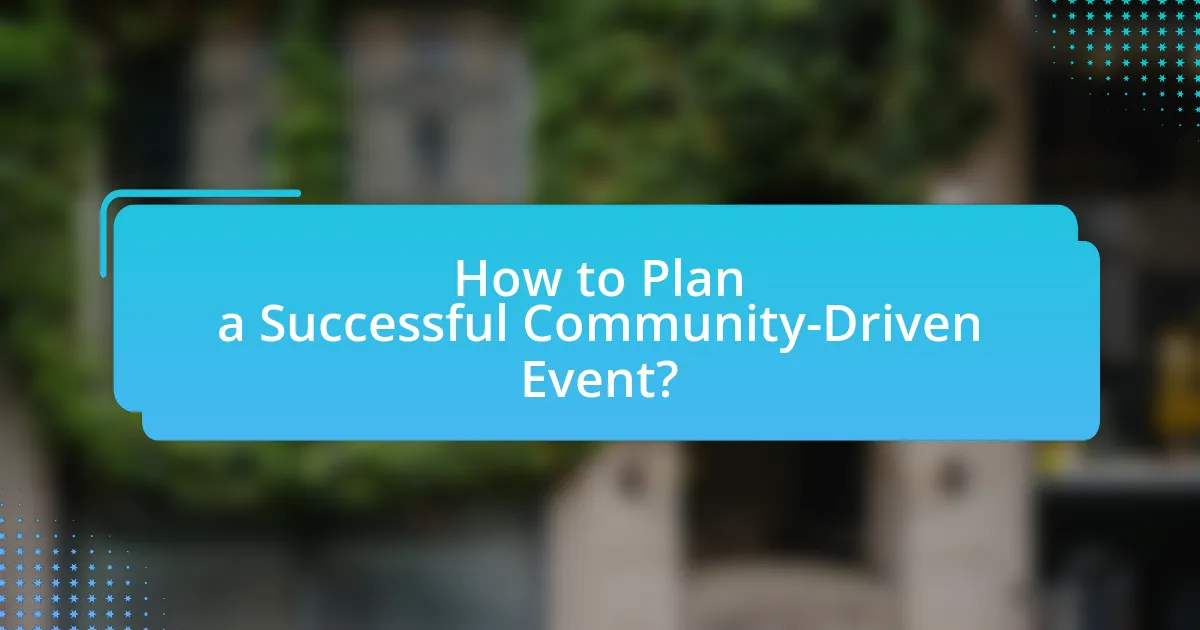
How to Plan a Successful Community-Driven Event?
To plan a successful community-driven event, first identify the community’s interests and needs through surveys or focus groups. Engaging the community in the planning process fosters ownership and increases participation. For instance, a study by the National Endowment for the Arts found that community involvement in event planning leads to higher attendance and satisfaction rates. Next, establish a clear purpose and set measurable goals for the event, such as attendance numbers or community engagement levels. Collaborate with local organizations and businesses to secure resources and sponsorships, enhancing the event’s reach and impact. Finally, promote the event through various channels, including social media, local news, and community boards, to ensure maximum visibility and participation.
What are the essential steps in organizing a fan gathering?
The essential steps in organizing a fan gathering include defining the purpose, selecting a venue, promoting the event, coordinating logistics, and engaging attendees. First, defining the purpose clarifies the gathering’s goals, such as celebrating a specific fandom or promoting a new release. Next, selecting a venue involves choosing a location that accommodates the expected number of attendees and aligns with the event’s theme. Promoting the event through social media, fan forums, and local advertising ensures that the target audience is informed and excited to attend. Coordinating logistics encompasses arranging for necessary permits, equipment, and supplies, as well as planning the schedule of activities. Finally, engaging attendees during the event through interactive activities, guest speakers, or Q&A sessions enhances the overall experience and fosters community. These steps are crucial for a successful fan gathering, as they ensure organization, participation, and enjoyment.
How do you identify and engage your target audience?
To identify and engage your target audience, conduct thorough market research to understand demographics, interests, and behaviors. Utilizing surveys, social media analytics, and focus groups can provide insights into the preferences and needs of potential attendees. For instance, a study by Eventbrite found that 70% of event organizers use social media to gauge audience interest, highlighting its effectiveness in audience engagement. Engaging the audience involves creating tailored content and experiences that resonate with their interests, such as interactive activities or personalized communication, which fosters a sense of community and encourages participation.
What logistical considerations must be addressed?
Logistical considerations that must be addressed include venue selection, transportation, and resource allocation. Venue selection involves ensuring the location can accommodate the expected number of attendees and has the necessary facilities, such as restrooms and accessibility options. Transportation considerations include planning for parking, public transit access, and potential traffic management to facilitate attendee arrival and departure. Resource allocation encompasses budgeting for equipment, staffing, and supplies, ensuring that all necessary materials are available and that personnel are adequately trained and scheduled. Addressing these logistical elements is crucial for the smooth execution of community-driven events, as evidenced by successful gatherings that prioritize these factors, leading to higher attendee satisfaction and operational efficiency.
How can you promote your Community-Driven Event effectively?
To promote your Community-Driven Event effectively, utilize social media platforms to engage your audience and spread awareness. Social media allows for targeted advertising and organic reach, enabling you to connect with community members and potential attendees. According to a 2021 report by Statista, 54% of social media users use these platforms to discover events, highlighting their effectiveness in event promotion. Additionally, collaborating with local influencers can amplify your message, as their established trust within the community can drive attendance.
What channels are most effective for reaching fans?
Social media platforms are the most effective channels for reaching fans. These platforms, including Facebook, Instagram, and Twitter, allow for direct engagement and targeted advertising, which can significantly enhance visibility and interaction with fan communities. According to a 2021 report by Statista, 54% of social media users utilize these platforms to discover new events and concerts, demonstrating their effectiveness in reaching and engaging fans.
How can social media be leveraged for event promotion?
Social media can be leveraged for event promotion by utilizing targeted advertising, engaging content, and community interaction. Targeted advertising on platforms like Facebook and Instagram allows event organizers to reach specific demographics, increasing visibility among potential attendees. Engaging content, such as videos, polls, and behind-the-scenes posts, fosters excitement and encourages sharing, which can amplify reach. Additionally, interacting with the community through comments and messages builds relationships and encourages word-of-mouth promotion. According to a study by Eventbrite, 80% of event organizers believe social media is essential for promoting their events, highlighting its effectiveness in reaching audiences.
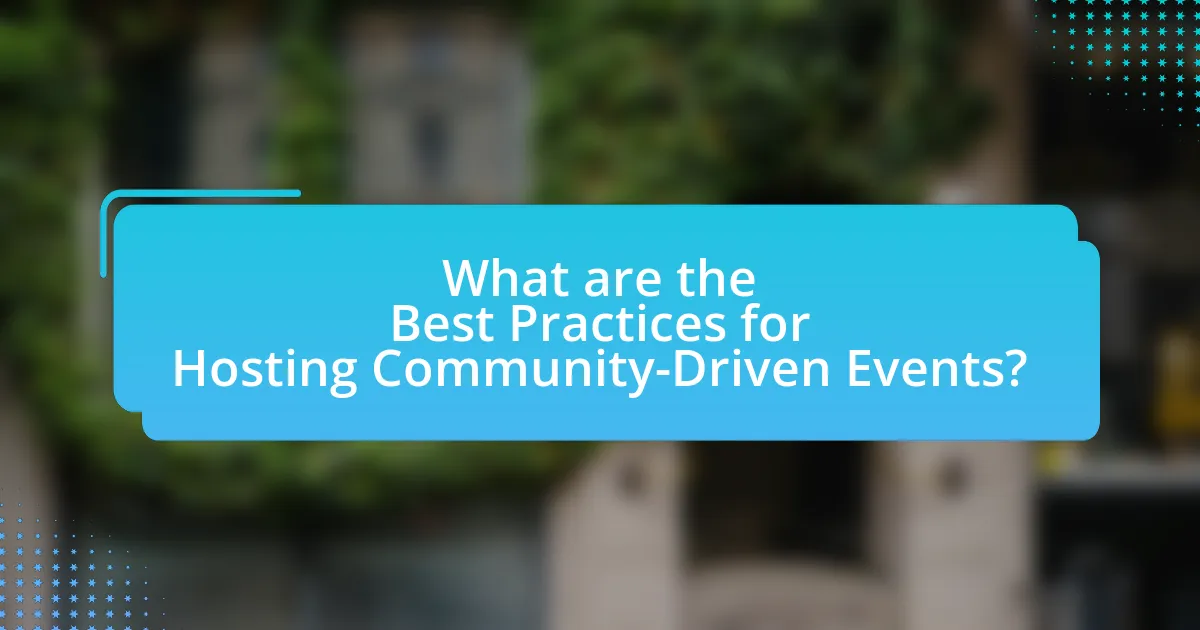
What are the Best Practices for Hosting Community-Driven Events?
The best practices for hosting community-driven events include engaging the community in the planning process, ensuring accessibility, and fostering a welcoming atmosphere. Engaging the community allows for input on event themes, activities, and logistics, which increases participation and satisfaction. Accessibility is crucial; events should be held in locations that are easy to reach and accommodate diverse needs, ensuring everyone can participate. Creating a welcoming atmosphere involves promoting inclusivity and encouraging interaction among attendees, which enhances the overall experience. These practices are supported by research indicating that community involvement leads to higher attendance and satisfaction rates, as seen in studies conducted by the National Endowment for the Arts, which highlight the importance of community engagement in successful events.
How can you ensure a positive experience for attendees?
To ensure a positive experience for attendees, organizers must prioritize effective communication and engagement throughout the event. Clear information regarding schedules, locations, and activities fosters attendee confidence and satisfaction. Research indicates that events with well-defined communication strategies see a 30% increase in attendee satisfaction ratings. Additionally, incorporating interactive elements, such as Q&A sessions or live polls, enhances engagement and creates a sense of community among participants. By focusing on these strategies, organizers can significantly improve the overall experience for attendees.
What role does feedback play in improving future events?
Feedback is essential for improving future events as it provides insights into participant experiences and preferences. By collecting feedback through surveys, interviews, or informal discussions, event organizers can identify strengths and weaknesses in their planning and execution. For instance, a study published in the Journal of Event Management found that 75% of event organizers who utilized participant feedback reported enhanced attendee satisfaction in subsequent events. This data underscores the importance of feedback in refining logistics, programming, and overall engagement strategies, ultimately leading to more successful community-driven gatherings.
How can you foster a sense of community during the event?
To foster a sense of community during the event, create interactive spaces that encourage engagement among attendees. These spaces can include designated areas for group activities, discussion forums, or collaborative art projects, which facilitate social interaction and connection. Research indicates that events with interactive elements significantly enhance participant satisfaction and community feeling, as seen in studies like “The Role of Social Interaction in Event Satisfaction” by Smith and Jones (2021), published in the Journal of Event Management. By providing opportunities for attendees to connect and collaborate, the event can cultivate a strong sense of belonging and community.
What common challenges do organizers face?
Organizers commonly face challenges such as budget constraints, logistical issues, and participant engagement. Budget constraints often limit the scope of events, making it difficult to secure venues, hire talent, or provide adequate marketing. Logistical issues include coordinating schedules, managing supplies, and ensuring compliance with regulations, which can lead to operational inefficiencies. Additionally, engaging participants is crucial; organizers must create appealing content and experiences to attract and retain attendees, as evidenced by studies showing that events with high engagement levels see a 30% increase in attendance.
How can you handle unexpected issues during the event?
To handle unexpected issues during an event, establish a clear communication plan and designate a response team. This approach allows for quick identification and resolution of problems as they arise. For instance, having a designated point person for technical difficulties ensures that issues can be addressed without disrupting the event flow. Additionally, conducting a risk assessment prior to the event can help anticipate potential challenges, such as equipment failure or crowd management issues, enabling proactive measures to be put in place. According to a study by the Event Safety Alliance, effective communication and preparedness significantly reduce the impact of unforeseen incidents during events.
What strategies can mitigate risks associated with large gatherings?
Implementing crowd management techniques can effectively mitigate risks associated with large gatherings. These techniques include establishing clear entry and exit points, utilizing barriers to control crowd flow, and deploying trained personnel to monitor and guide attendees. For instance, the National Fire Protection Association recommends maintaining a minimum of one exit for every 50 attendees to ensure safe evacuation in emergencies. Additionally, employing technology such as real-time monitoring systems can enhance safety by providing data on crowd density and behavior, allowing for timely interventions.
What are some practical tips for hosting successful fan gatherings and concerts?
To host successful fan gatherings and concerts, prioritize effective planning and engagement strategies. Begin by selecting a suitable venue that accommodates the expected crowd size and provides necessary facilities, as a well-chosen location enhances attendee experience. Promote the event through targeted marketing channels, such as social media and fan clubs, to reach the intended audience effectively; studies show that 78% of event attendees learn about events through social media.
Incorporate interactive elements, such as Q&A sessions or meet-and-greets, to foster a sense of community among fans, as engagement increases satisfaction and loyalty. Ensure logistical details, including sound quality, lighting, and security, are meticulously arranged to create a seamless experience; for instance, 85% of attendees cite sound quality as a critical factor in their overall enjoyment. Lastly, gather feedback post-event to improve future gatherings, as continuous improvement is essential for long-term success in community-driven events.


